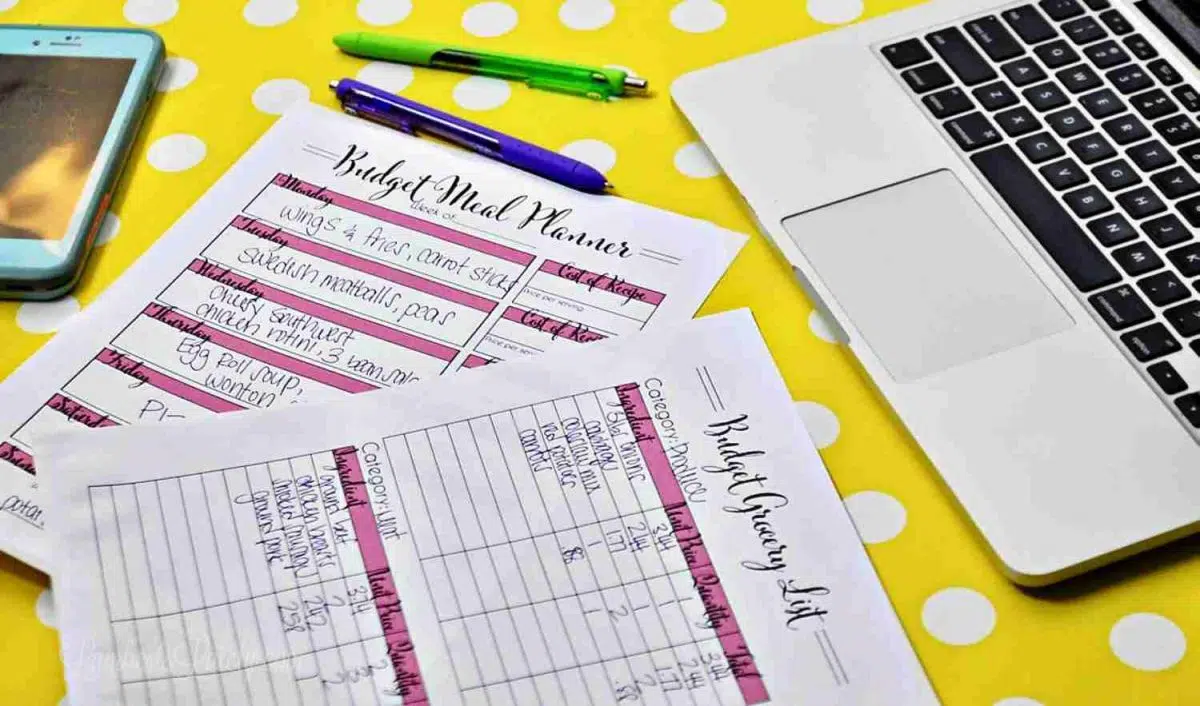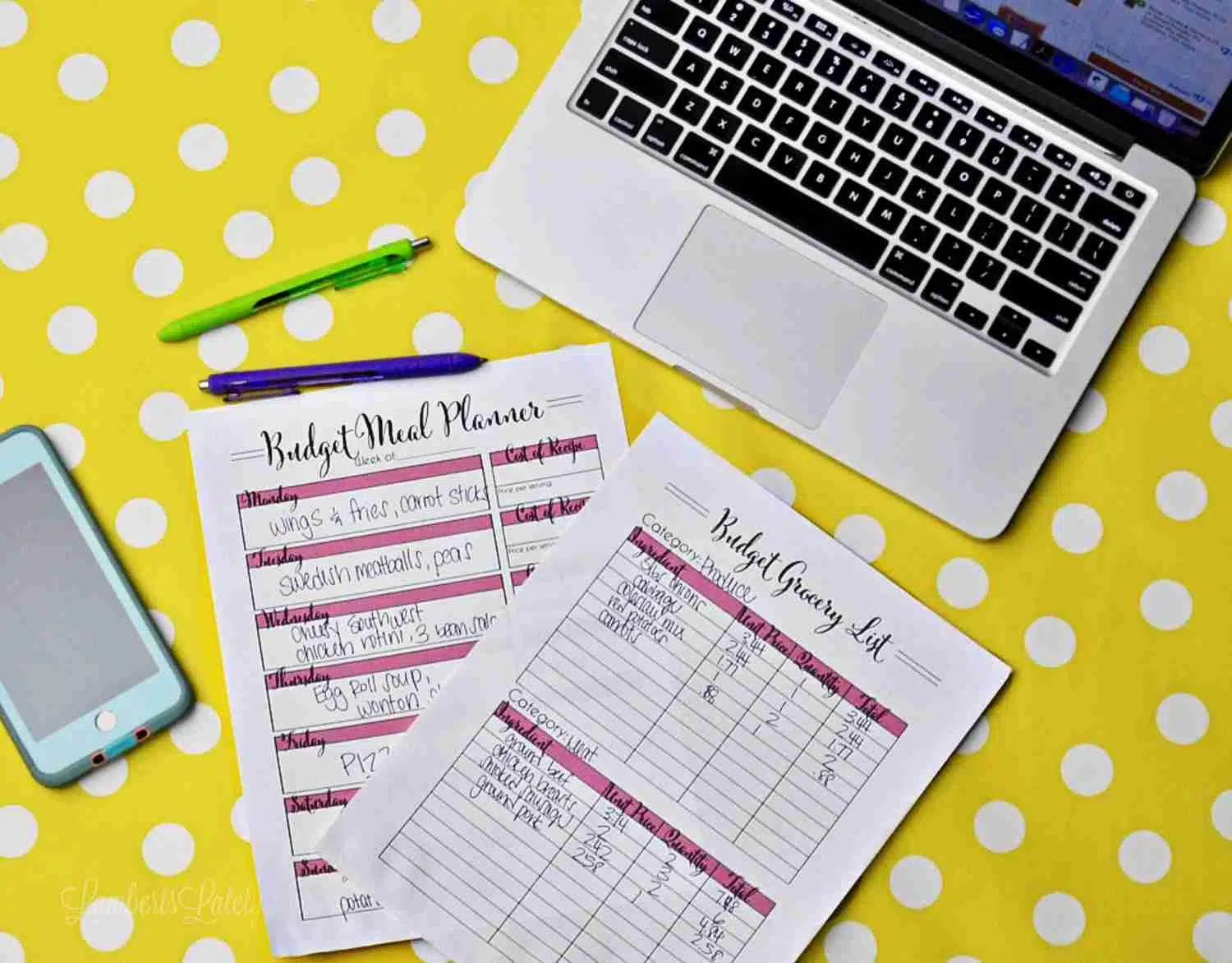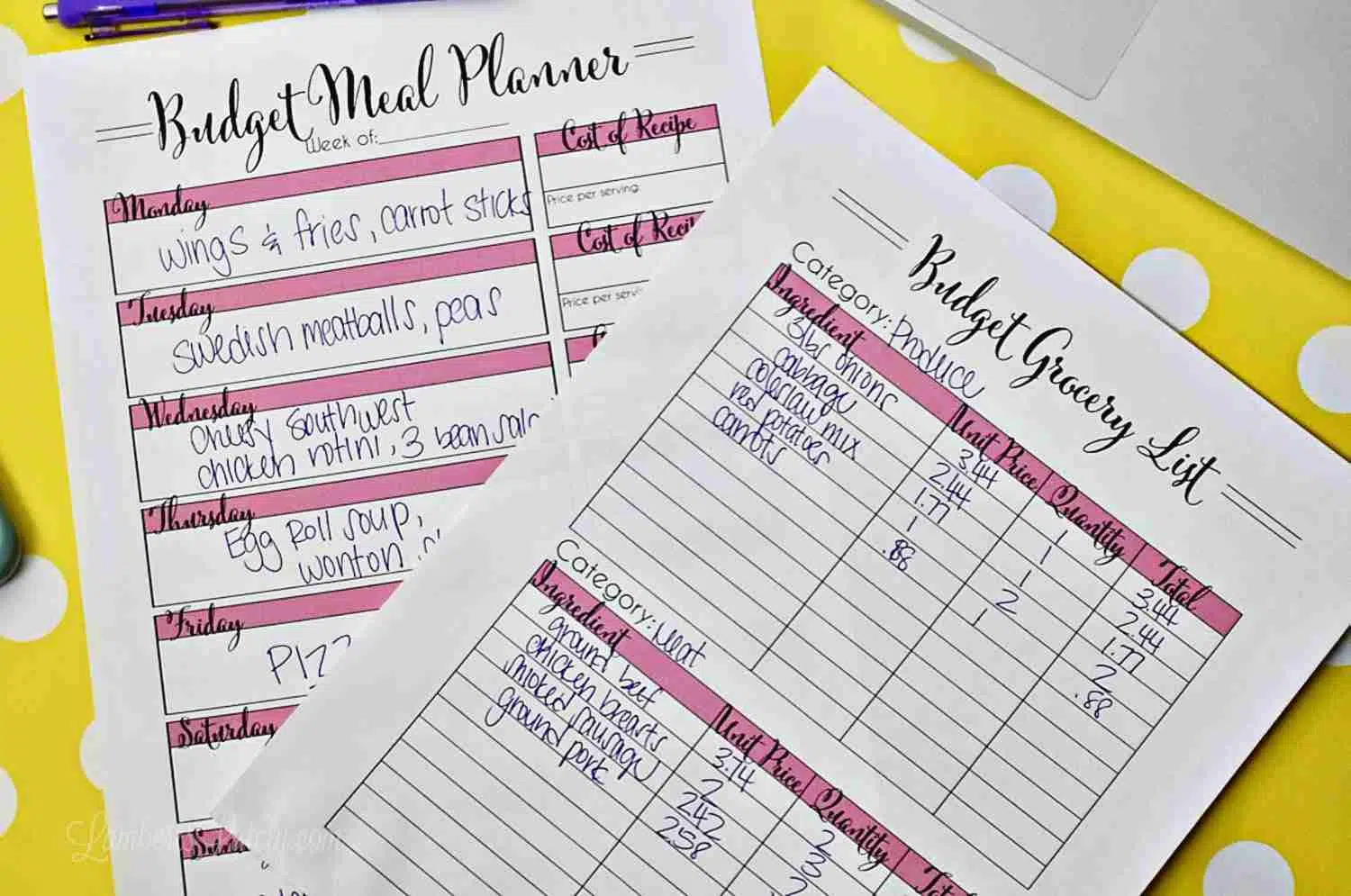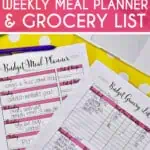Ready to start meal planning in style? This post has two free printable weekly meal planners (pdf) and a grocery list, with tips on weekly meal planning on a budget.

Paid links used in this post. Read more about my link usage policies.
In the past few years, I've acquired some experience in the meal prep department. I'm currently sitting at 26 different freezer meal boot camps (and that's not counting the ones that I've published before on the blog). Making these meal plans has been a challenge, but I've learned so much about how to organize the process and save money on your overall grocery budget!
One of the most important things about meal planning and meal prep is being prepared. Going into the week without a solid meal plan is setting yourself up for failure. With just a little bit of time once a week, you can build a weekly menu planner that the whole family loves.
Today, I've got the perfect printables for organizing your weekly meal plan in style. You can grab a budget meal planner and a weekly meal plan template...they're both free downloads! Organize your grocery shopping and have a planned menu that family members can easily reference.
How to Print the Meal Planners & Grocery List
The files that are linked to the buttons below are in pdf format. Simply click the button to have the pdf file open in a new window. You can either download the templates to your device (with the downward-facing arrow) or print them (with the printer icon).
These are all free printables...no strings attached! All three of these printable pdf pages are formatted to print on 8.5x11" standard printer paper. An at-home printer works just fine - this is the printer I currently use.
You can print as many copies as you'd like for personal use. I recommend printing one per week. If you're trying to save paper, some readers like to laminate their meal plan and use a wet-erase marker to change out from week to week.
Want to take it digital? I've also got a Google Sheets Meal Planner that's free to download!
Download: Printable Weekly Meal Planner PDFs
Now, let's get to those free printable weekly meal planners!

The standard weekly meal planner has enough space to brainstorm meals for that week and jot down notes about items you might need to buy, prep time for a meal, important days to remember, or other notes you'll need to prepare that dish.
I love planning my meal plans a week at a time, with a Monday start. You'll see all 7 days of the week on these pages, running from Monday-Sunday. By putting the weekend at the end of your weekly meal plan, you can leave a little bit of wiggle room to use up leftovers or extra pantry items each week. It helps so much to reduce food waste and squeeze the most out of your budget.
The budget weekly meal planning printable allows you to schedule your meals and analyze overall meal cost (using your grocery planning sheet) and price per serving. This is wonderful to save for later to help with future budget meal planning as well - no need to do the work twice!
Download: Printable Grocery List Template PDF

This is a complementary printable to the meal planning templates. After deciding on my weekly meal plan, I write down ingredients in each grocery category (meat, produce, canned & packaged, dairy, frozen, and bakery), quickly research the cost of each unit that week, and use that number to figure my overall grocery budget. From there, you can cut and replace ingredients as needed to reduce your budget and make your final shopping list.
Don't forget to add snacks, drinks, breakfast items, and other staples that aren't ingredients for your meals!
More Printables: Monthly Meal Planner, Meal Brainstorming, Favorite Meals List, etc.
These two printables match a much more extensive meal and grocery planning set I have in The Year of Intent, my mega collection of planner printables. You'll find monthly meal planner, bi-weekly planner, meal ideas brainstorming sheet, favorite meals list, and so much more in that collection.
Step-by-Step: How to Use Printable Weekly Meal Planner
Step 1: Pick a time each week to plan.
Start out by picking a consistent time that you'll meal plan each week. There's something about having a schedule with meal planning that "trains your brain" to keep the habit. I personally like meal planning on Sunday nights and doing my grocery shopping on Mondays. Your mileage may vary - different schedules work for different people.
That meal planning session starts with me looking over our family schedule for the week. If we have an event or practice at night, I know I might need to make that an easy meal or a leftover night. Also, note those nights that you won't be eating at home.
Step 2: Inventory what ingredients you have.
Before I think of any recipes, I like to look in my pantry and refrigerator to see what ingredients we already have. I always try to integrate those into my meals to use them, concentrating on things that will spoil quickly (like produce or meats).
Step 3: Think of favorites.
After thinking of a recipe or two that uses up ingredients we have, I tie in a family favorite or two. Every family has a few tried-and-true recipes they love: spaghetti, tacos, roast chicken, soups, etc. Those are easy because a) you already know the recipe and b) the ingredients are the kind that you either already have or can easily obtain. Tie some of those in to give yourself a breather here and there!
Step 4: Try something new.
If you still need any meals, think outside of the box. Put at least one thing on your family's menu that is different or unique from what you normally cook. I'm a big believer in exposing kids to new and different flavors, and that starts at home. Even if your family hates it - you never know until you try.
Step 5: Make your grocery list.
Now, take your recipes and divide those up into the grocery list printable you see above. That list lets you divide it by category, making for super easy shopping.
Step 6: Let everybody else know.
Once you've made the list and done your shopping, post the list somewhere! It's so easy to prevent those "what's for dinner" questions when you have a meal plan posted for the week that the whole family can reference.
5 Effective Budget Meal Planning Tips
Making the budget meal plans was one of the biggest challenges of my Freezer Meal Boot Camps. I've never really focused on ingredient cost with my other meal plans, so I've definitely learned a few surefire tips and tricks that optimize my budget.
At the same time, I don't want to just fill the recipes with junk. You have to find a balance between cost-effective, healthy, and tasty.
1. Start by picking the right recipes.
Any good meal planner will tell you that, after assessing what ingredients you already have on hand, the most essential step in meal planning is picking your recipes. I don't need to tell you how many recipes are available out there - you imagine it, it's there. But, with budget meal planning, a huge factor is picking recipes that stretch your budget.
Look for recipes that line up with sales that might be happening at your local grocery stores every week. I use Walmart grocery pick-up and, especially with meats, I'll often find sales and discounts on more expensive cuts. Just browse the site (by searching "meat") before picking your recipes! The discounted ones will have a price crossed out with the sale price next to it in red.
I also tend to shy away from more expensive (and often unnecessary) ingredients. Spices (especially those that are used very sparingly in recipes) can often bump up your grocery bill, so if a recipe is loaded with them, stay away from it.
2. Watch meat and veggie costs.
Each time I write out my weekly meal plan or a boot camp, I write out my grocery list and quickly (using the Walmart grocery site) jot down each ingredient's cost to make sure my overall bill is right around $100 for 10 meals. Usually, the main culprits for a bill that's too high are expensive cuts of meat and/or vegetables. Now, obviously, these are typically important parts of a meal - but there are ways to cut them that don't cut the freshness or nutrition of a meal.
Shy away from produce that is more expensive because it's out of season or obscure. Stick with the essentials: carrots, cabbage, celery, bell peppers, squash, potatoes, and many others I'm not thinking of right now are great ways to load your meals up with vegetables without breaking the bank. If you're cooking them, definitely don't be scared of frozen veggies. Frozen produce often holds most (if not all) of the nutrients of fresh and can really cut your grocery bill.
With meats, I generally try to stay below $5 a pound in a budget plan. Yes, that eliminates many of your better cuts of meat, but you can still find lean & nutritious options at the price point. Most chicken cuts (including boneless, skinless breasts), ground meats, pork chops, etc. can be found at this rate, especially if you shop sales. Bonus points if you can even plan a protein-rich meal that is completely meatless - these are great for a budget!
3. Cut the fluff.
With each recipe, scan the ingredient list for fluff. If it doesn't add flavor or nutrition to the meal, cut it. As I mentioned earlier, tiny amounts of expensive ingredients can often be a red flag in a recipe. If you can cut even one or two of them, do it. It will make a difference in your budget.
Also, look for ways you can make expensive pre-made ingredients at home. I love making my own Instant Pot chicken broth. It's a huge money saver for things like soups. Instead of using spice blends from the grocery store, you can always make things like taco seasoning and chili seasoning at home. These are easy to whip up and use for months right from your pantry.
4. Cook/freeze in bulk.
Now you guys know I'm a fan of this. 🙂 Not only is bulk freezer cooking a massive time-saver, but it's a great cost-cutter as well. If you're anything like me, you throw away past-prime produce all the time when it's stored in the fridge for cooking. Ingredients have a much, much longer shelf life when frozen. I easily store meals for 6 months in the freezer.
In addition to saving you from wasted food, bulk freezer cooking allows for bulk ingredient buying as well. You'll get more bang for your buck by purchasing your ingredients in larger quantities.
If you're not a huge fan of freezer cooking, at least consider the "cook it once, eat it twice" rule. Cook a double portion of your meals and eat them for a couple of nights in a row. Yes, this is a little bit boring sometimes, but it allows you to buy ingredients in bulk for big grocery savings.
5. Keep it simple.
I've found in my research for current budget boot camps that, the smaller the ingredient list, the smaller the cost. This kind of goes with the cutting-the-fluff rule above. By narrowing your recipes (and, overall, your grocery list) down to a few simple and essential ingredients, you're reducing the waste of lots of sparingly-used ingredients in your pantry.
FAQs
Now go forth and meal plan - hopefully you got a few cost-cutting tips from this post! See more of my useful home printables below.

